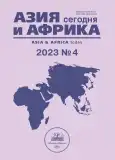Меньшинства в современном Иране: стратегии «борьбы за идентичность»
- Авторы: Богачева А.С.1
-
Учреждения:
- ИМЭМО им. Е.М. Примакова РАН
- Выпуск: № 4 (2023)
- Страницы: 45-53
- Раздел: Политика, экономика
- URL: https://journals.rcsi.science/0321-5075/article/view/140890
- DOI: https://doi.org/10.31857/S032150750021997-8
- ID: 140890
Цитировать
Полный текст
Аннотация
Список литературы
- Elling R.C. Minorities in Iran Nationalism and Ethnicity after Khomeini. London: Palgrave Macmillan, 2013. 267 p.
- Семененко И.С., Лапкин В.В., Пантин В.И. Социальные размежевания и политические противостояния в научном дискурсе: критерии оценки и классификации. Полис. Политические исследования. 2021, № 5. С. 8–16.
- Кудряшова И.В., Харитонова О.Г., Хенкин С.М. Метаморфозы разделенных обществ. М.: МГИМО-Университет, 2020. 284 с.
- Ahmadi H. Ethnicity and ethnonationalism in Iran. Tehran: Nashrani, 1999. 447. (In Pers.)
- Ghafoor S.M. T., Zoheiri A. 2016. Identity politics and new social movements. Political science. № 74. P. 119–140. (In Pers.)
- Мамедова Н.М. Культурная сложность современного иранского общества. Труды Института востоковедения РАН. 2019, № 26. С.116.
- Каменева М.С. Армяне, евреи и бахаи в Иране: проблемы социально-культурного развития. Азия и Африка сегодня. 2020. № 1. С. 25–31.
- Раванди-Фадаи Л.М. Этно-конфессиональные проблемы в современном Иране. Иран при М. Ахмадинежаде. М.: ИВ РАН, 2013. С. 172.
- Meyers B. 1984 Minority group: An ideological formulation. Social Problems. Vol. 32. № 1. Pp. 1–15.
- Feagin J.R. Racial and Ethnic Relations (2nd ed.). New Jersey, 1984. Prentice-Hall. P. 10.
- Дилигенский Г.Г. Социально-политическая психология. М.: Новая школа, 1996. С. 201–203.
- Панова О.В. Идентичность и социальное действие. Идентичность: Личность, общество, политика. Энциклопедическое издание. М.: Издательство «Весь Мир», 2017. С. 694.
- Ионин Л.Г. Восстание Меньшинств. М.: Университетская книга, 2012. С. 86.
- Семененко И.С. Политика идентичности. Идентичность: Личность, общество, политика. Энциклопедическое издание. М.: Издательство «Весь Мир», 2017. С. 648.
- Семененко И.С. Политика идентичности: меняющаяся повестка дня. Символическая политика. М.: ИНИОН, 2017. С. 23–24.
- Ghafur S.M.T., Zoheiri A. 2016. Identity politics and new social movements. Political science. № 74. Pp. 119–140. (In Pers.)
- Гафур С.М. Роль культуры в политической структуре современного Ирана. Идейные процессы в Иране. М.: Садра, 2017. С. 133–134.
- Раванди-Фадаи Л.М. Этнос, нация и национализм: иранский взгляд. Нации и национализм на мусульманском Востоке. М.: ИВ РАН, 2015. С. 202.
- Кудряшова И.В. Иран как случай исламской модернизации. Политическая наука. 2012, № 2. С. 107–133.
- Amanolahi S. 2005. A Note on Ethnicity and Ethnic Groups in Iran. Iran and the Caucasus. Vol. 9, № 1. Pp. 37–42.
- Наумкин В.В. Модель не-Запада: существует ли государство-цивилизация? Полис. Политические исследования. 2020, № 4. С. 78–93.
- Аликберов А.К. Проблемы системной классификации религий. Ислам в современном мире: внутригосударственный и международно-политический аспекты. 2018. Т. 14. № 3. С. 187.
- Abutarabi. H. Unity and cohesion, material and spiritual development of Islamic nations. Collection of materials of the conference “Festival of the best scientific works in the field of Islamic humanities”. Qom, 2017. 17 p. (In Pers.)
- Попов М.Е. Конфликт идентичностей. Идентичность: Личность, общество, политика. Энциклопедическое издание. М.: Издательство «Весь Мир», 2017. С. 295.
- Шестопал Е.Б. Политическая психология. М: Аспект Пресс, 2018. С. 330–333.
- Вертяев К.В., Жигалина О.И., Иванов С.М. Политические процессы в курдских ареалах стран Западной Азии: Ираке, Турции, Сирии, Иране. М.: ИВ РАН, 2013. С. 110.
Дополнительные файлы











